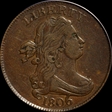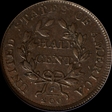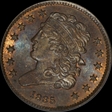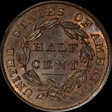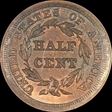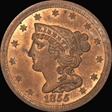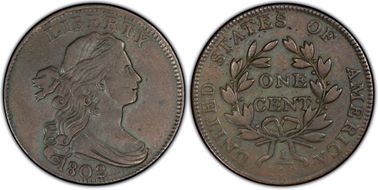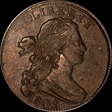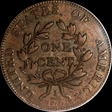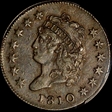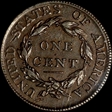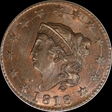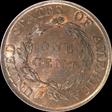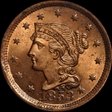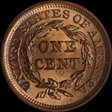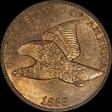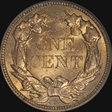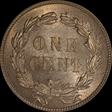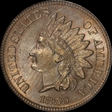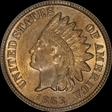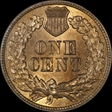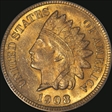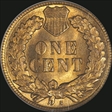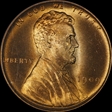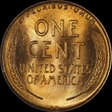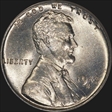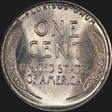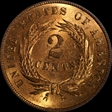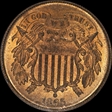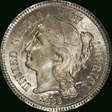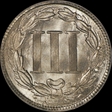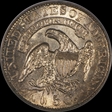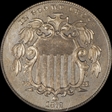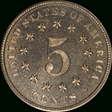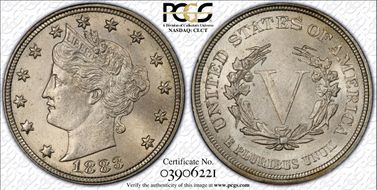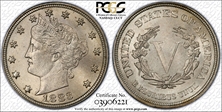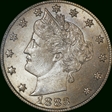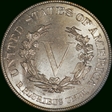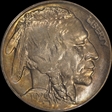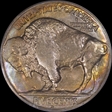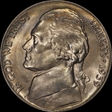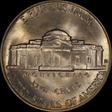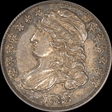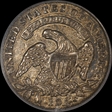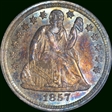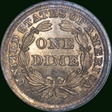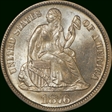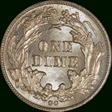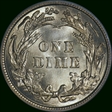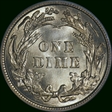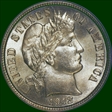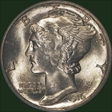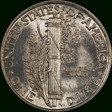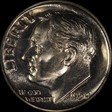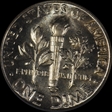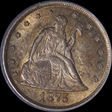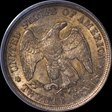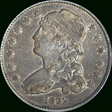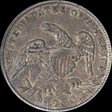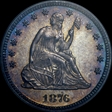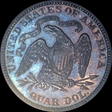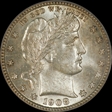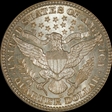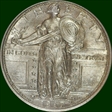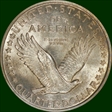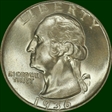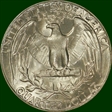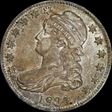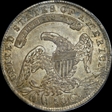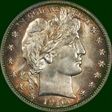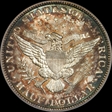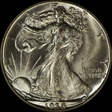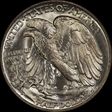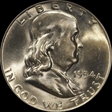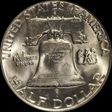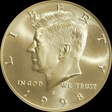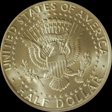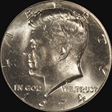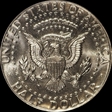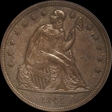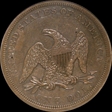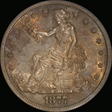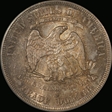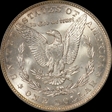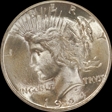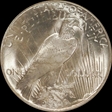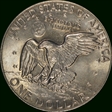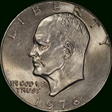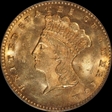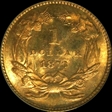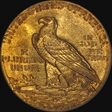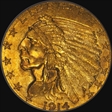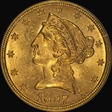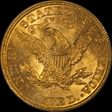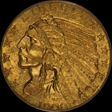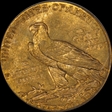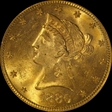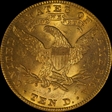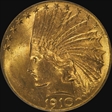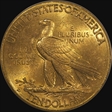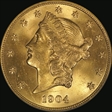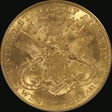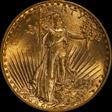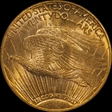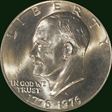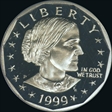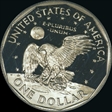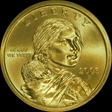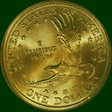Overland Trail 的钱币相册
Mintage: 239,000. Draped Bust. Designed by Robert Scot. Large quantities exist from the Chapman Hoard, some red. This VF35 example is chocolate brown with even wear and good strike. Large 6 with Stems variety.
Mintage: 239,000. Draped Bust. Designed by Robert Scot. Large quantities exist from the Chapman Hoard, some red. This VF35 example is chocolate brown with even wear and good strike. Large 6 with Stems variety.
Boldly struck with clean, mark-free surfaces. Some spotty red areas, possibly from the Elmer Sears hoard. Designed and modified by William Kneass. A scarce issues in MS65
Boldly struck with clean, mark-free surfaces. Some spotty red areas, possibly from the Elmer Sears hoard. Designed and modified by William Kneass. A scarce issues in MS65
Mintage:56,500. Coronet Type designed by Christian Gobrecht. Lustrous near red surfaces adorn the obverse with spotty red reverse. Possibly from a hoard of pieces distributed by Pittsburgh dealer A. C. Giles. A scarce issues residing in an old green holder.
Mintage:56,500. Coronet Type designed by Christian Gobrecht. Lustrous near red surfaces adorn the obverse with spotty red reverse. Possibly from a hoard of pieces distributed by Pittsburgh dealer A. C. Giles. A scarce issues residing in an old green holder.
Robert Scot designed this coin of Miss Liberty with mintage commencing in 1796 and continuing until 1807. It is one of the more common dates with a mintage of over 3 million. This coin has an even chocolate coloration and nice strong strike.
Robert Scot designed this coin of Miss Liberty with mintage commencing in 1796 and continuing until 1807. It is one of the more common dates with a mintage of over 3 million. This coin has an even chocolate coloration and nice strong strike.
Robert Scot designed this coin of Miss Liberty with mintage commencing in 1796 and continuing until 1807. It is one of the more common dates with a mintage of over 3 million. This coin has an even chocolate coloration and nice strong strike.
While difficult to find without deficiencies, this nicely, chocolate toned issue has good strike on an unusually well made planchet with even surfaces. Most Classic cent are plagued by poorly made planchets and poor strikes.
While difficult to find without deficiencies, this nicely, chocolate toned issue has good strike on an unusually well made planchet with even surfaces. Most Classic cent are plagued by poorly made planchets and poor strikes.
Note the die break "connected stars". This coin was most likely part of the Randall Hoard. Well preserved and nearly mark free.
Note the die break "connected stars". This coin was most likely part of the Randall Hoard. Well preserved and nearly mark free.
Cartwheel lustre and amazingly red color. Looks like it was minted yeasterday
Cartwheel lustre and amazingly red color. Looks like it was minted yeasterday
Due to the rising expense of making large copper cents the small flying eagle cent was designed and began production in 1856
Due to the rising expense of making large copper cents the small flying eagle cent was designed and began production in 1856
Poor strike quality of the flying eagle cent brought about the redesign of the small cent in 1859
Poor strike quality of the flying eagle cent brought about the redesign of the small cent in 1859
Union sympathy during the "War of Northern Aggression" caused the addition of the shield on the reverse. It remained there until the end of the design in 1909.
Union sympathy during the "War of Northern Aggression" caused the addition of the shield on the reverse. It remained there until the end of the design in 1909.
First cent struck at a branch mint. The "S" mint mark was added to the reverse of this beautiful, red and lustrous example. It looks just like it was minted yesterday.
First cent struck at a branch mint. The "S" mint mark was added to the reverse of this beautiful, red and lustrous example. It looks just like it was minted yesterday.
Honoring Abraham Lincoln's 100th birthday the cent was redesigned in 1909. The tiny reverse VDB initials for designer Victor D. Brenner caused an uproar resulting in their removal the same year.
Honoring Abraham Lincoln's 100th birthday the cent was redesigned in 1909. The tiny reverse VDB initials for designer Victor D. Brenner caused an uproar resulting in their removal the same year.
Due to WWII all copper was removed from 1-cent pieces. The mint resorted to zinc plated steel planchets to produce these coins. This gem looks to be minted yesterday
Due to WWII all copper was removed from 1-cent pieces. The mint resorted to zinc plated steel planchets to produce these coins. This gem looks to be minted yesterday
The 1995 cent is the last major double die of the Lincoln series. Due to new manufacturing processes major double dies are no longer possible.
The 1995 cent is the last major double die of the Lincoln series. Due to new manufacturing processes major double dies are no longer possible.
The two cent piece was produced to make up the slack in the hoarding of silver and gold coinage. Only partly successful due to eventual hoarding of all metal U. S. coinage during the war.
The two cent piece was produced to make up the slack in the hoarding of silver and gold coinage. Only partly successful due to eventual hoarding of all metal U. S. coinage during the war.
Only silver three cent piece minted in New Orleans. This denomination circulated widely when other small silver coinage was being melted and exported. Being only 75% silver and 25% copper the alloy was know as billion and worth less than 3 cents, thus our first subsidiary coinage. Note the bold "O" mint mark.
Only silver three cent piece minted in New Orleans. This denomination circulated widely when other small silver coinage was being melted and exported. Being only 75% silver and 25% copper the alloy was know as billion and worth less than 3 cents, thus our first subsidiary coinage. Note the bold "O" mint mark.
Big nickel interest influenced Congress to produce a new nickel three cent piece. Mainly used for redemption of booklets of 3-cent notes, derogatorily called shinplasters, and finally discontinued in 1889.
Big nickel interest influenced Congress to produce a new nickel three cent piece. Mainly used for redemption of booklets of 3-cent notes, derogatorily called shinplasters, and finally discontinued in 1889.
Bold strike and outstanding luster with only the slightest toning at the periphery graces this carefully preserved example, An obverse clash mark occupies the field from nose to neck.
Bold strike and outstanding luster with only the slightest toning at the periphery graces this carefully preserved example, An obverse clash mark occupies the field from nose to neck.
With virtually no silver or gold coins circulating the mint chose to strike 5-cent nickel pieces similar to their 3-cent cousins. Difficulty with the hardness of the metal caused many specimens show cracked dies, clash marks, and other mint errors. This coin Is a proof DDO, a very unusual proof with all 500 coins from one die.
With virtually no silver or gold coins circulating the mint chose to strike 5-cent nickel pieces similar to their 3-cent cousins. Difficulty with the hardness of the metal caused many specimens show cracked dies, clash marks, and other mint errors. This coin Is a proof DDO, a very unusual proof with all 500 coins from one die.
The redesigning of the five cent piece in 1883 was another collossal blunder by the mint's engraving staff. The "NO CENTS", "Racketter Nickel" variety depicted here was widely gold plated and passed as a gold half eagle. This specimen is from the famed Eliasberg Collection.
The redesigning of the five cent piece in 1883 was another collossal blunder by the mint's engraving staff. The "NO CENTS", "Racketter Nickel" variety depicted here was widely gold plated and passed as a gold half eagle. This specimen is from the famed Eliasberg Collection.
The redesigning of the five cent piece in 1883 was another collossal blunder by the mint's engraving staff. The "NO CENTS", "Racketter Nickel" variety depicted here was widely gold plated and passed as a gold half eagle. This specimen is from the famed Eliasberg Collection.
The redesigning of the five cent piece in 1883 was another collossal blunder by the mint's engraving staff. The "NO CENTS", "Racketter Nickel" variety depicted here was widely gold plated and passed as a gold half eagle. This specimen is from the famed Eliasberg Collection.
Ample mint luster peers through the dark, crusty toning of this well struck 1830's work-horse Philadelphia issue.
Ample mint luster peers through the dark, crusty toning of this well struck 1830's work-horse Philadelphia issue.
Old and even gray toning with some luster clinging to and around the devices. Some dirt still adheres to the wings, shield, and lettering.
Old and even gray toning with some luster clinging to and around the devices. Some dirt still adheres to the wings, shield, and lettering.
Silvery gray coloration with plenty of minty luster adorns the silky smooth fields of this Philadelphia issue.
Silvery gray coloration with plenty of minty luster adorns the silky smooth fields of this Philadelphia issue.
Sharp strike with peripheral gold and green blending to icy-white centers.
Sharp strike with peripheral gold and green blending to icy-white centers.
This example exhibits bold strike, just the slightest wear on the high points, and a satiny luster below the even gray toning.
This example exhibits bold strike, just the slightest wear on the high points, and a satiny luster below the even gray toning.
Exquisite rainbow toning adorns the obverse of this so called "Daddy Dollar". Despised for decades this original toning is the result of bag storage at the mint or various depositories.
Exquisite rainbow toning adorns the obverse of this so called "Daddy Dollar". Despised for decades this original toning is the result of bag storage at the mint or various depositories.
1851 Type One-Closed Wreath. Mintage: 3,317,671. The California gold rush had a profound impact on our nation's coinage. The dramatic influx of gold from the mines in California changed the gold to silver ratio lowering the value of gold in relation to silver. Silver coins became all but extinct as they headed toward the melting pot. All that circulated were copper coinage and gold coinage starting at the quarter eagle denomination. The resultant 1849 coinage included two new denominations, the gold dollar and the double eagle. The silver trime followed in 1851 but did little to solve the coinage crisis as silver coins continued to be taken out of circulation to be melted. The situation was solved by the reduction of silver content in most silver denominations in 1853. The tiny dollars were made in the millions and circulated widely until the outbreak of the "War of Northern Aggression"
1851 Type One-Closed Wreath. Mintage: 3,317,671. The California gold rush had a profound impact on our nation's coinage. The dramatic influx of gold from the mines in California changed the gold to silver ratio lowering the value of gold in relation to silver. Silver coins became all but extinct as they headed toward the melting pot. All that circulated were copper coinage and gold coinage starting at the quarter eagle denomination. The resultant 1849 coinage included two new denominations, the gold dollar and the double eagle. The silver trime followed in 1851 but did little to solve the coinage crisis as silver coins continued to be taken out of circulation to be melted. The situation was solved by the reduction of silver content in most silver denominations in 1853. The tiny dollars were made in the millions and circulated widely until the outbreak of the "War of Northern Aggression"
The 1857-O is the last quarter eagle issued from the New Orleans Mint. This piece has beautiful green gold coloration with deep golden coppery toning. With this look it was probably part of the Jackson Hoard. There are a few minute scratches from excavation of these coins.
The 1857-O is the last quarter eagle issued from the New Orleans Mint. This piece has beautiful green gold coloration with deep golden coppery toning. With this look it was probably part of the Jackson Hoard. There are a few minute scratches from excavation of these coins.
Ex Bass. Yellow gold with golden coppery accents. Luster somewhat subdued as usually seen with this issue
Ex Bass. Yellow gold with golden coppery accents. Luster somewhat subdued as usually seen with this issue




















